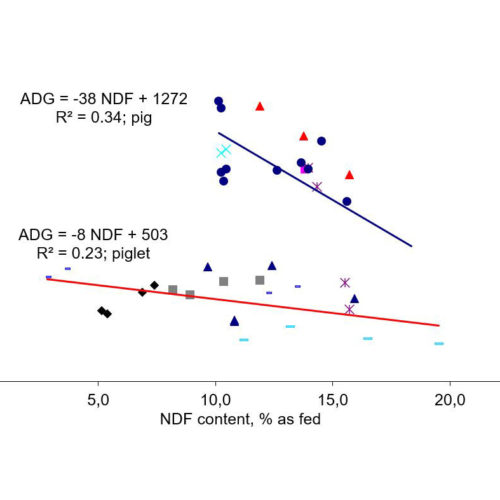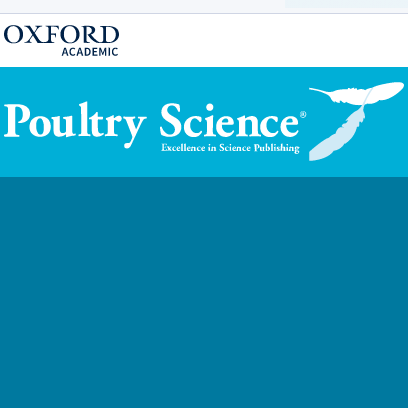Dietary fibre received a large attention in animal nutrition associated with important effect on various aspect, behaviour, welfare, digestibility and performance. Fibre-rich feeds such as co-products from food and biofuel industries, e.g., wheat bran (WB), corn bran (CB), soybean hulls (SBH),sugar beet pulp (SBP), and distillers dried grains with soluble (DDGS), have been applied to pig diets to save costs. These fibre-rich feeds generally were considered to have low nutritional value due to the lower digestive energy or amino acid levels compared to concentrated feeds with high starch or proteins (Woyengo et al., 2014). Best use of these products is very important for animal production sustainability.
Fibre in animal nutrition impact on performance
The effect of high-fiber ingestion has generally been to reduce pig growth rate. However, the reports obtained have often been contradictory. Synthesis of internal and published studies have been performed (Figure 1) and clearly demonstrate the detrimental effect of fibre evaluated as NDF on growing pig and piglet.
This synthesis demonstrates negative correlation between NDF and performance. It also suggests a highest detrimental effect for pig compare with piglet.
Fibre impact the digestibility of all nutrients
Majority of studies investigating the effects of DF on nutrient digestibility have shown that DF reduced nutrient digestibility (Gutierrez et al.,2014; Urriola and Stein, 2010; Chen et al., 2013; Navarro et al., 2018; Zhao et al., 2019a). Extensive work was performed by Le Goff and Noblet (2000). Authors suggested 0.9% unit decrease of gross energy digestibility per percent units of NDF for growing pigs. This value contrast with value measured for adult less affected by adult pigs.
Several mechanisms have been put forward to explain the negative impact of high-fiber diets on nutrient digestion. In this context, soluble fiber has been reported to increase digesta viscosity and thereby slow down the diffusion of the substrate and enzymes in the porcine small intestine, which hampers nutrient digestion and absorption. Hampering process affects all the nutrient as suggested Table 1.
Digestibility results obtained on various products from wheat and corn category suggest good correlation among digestibility and acid detergent fibre (ADF). Slope are common for dry matter and organic matter -3.0 and -3.6 for wheat and corn, respectively. Macro nutrient digestibility (i.e. crude fat, nitrogen, crude fibre and energy) follow a similar negative correlation with ADF. For wheat and wheat by-products 1% unit increase of ADF content result in 1.9% unit decrease of digestibility. Similarly, for corn and corn by-products 1% unit increase of ADF content result in 2.5% unit decrease of digestibility. These results demonstrate the discrepancy of metabolic effect of ADF from two different raw material families.
From fibre in animal nutrition to fibre in enzyme development
Dietary fibre (DF) was first defined in the context of human medicine by Towell et al. (1976) as the “the sum of lignin and polysaccharides that are not digested by endogenous secretions of the digestive tract of man”. Such a definition is also commonly used for other non-ruminant animal species. For feed production, fibre is usually a mixture of several of these polysaccharides which have different physicochemical properties and different physical characteristics, together with varying proportions of fibre type (McDouglas et al., 1996). Detailed and official descriptions of the analytical procedures have been published for all these parameters (Weende, 1850; Goering and Van Soest, 1970; Prosky et al., 1985; Carre et Brioullet, 2006). These methods balance from the most exhaustive dietary fibre analysis, total dietary fibre (TDF) to the least crude fibre (CF). Crude fibre method has been used since the middle of the 19th century and is based on sequential extraction with diluted acid and alkali solution. These methods are useful for feed production. Nevertheless, other methods like NIRS (near infrared spectroscopy, PNE for Adisseo) can now supply other information like AX content calculation that can be of some interest either when it comes to enzyme usage. Figure 3 suggests the small relationship among NDF and arabinoxylan content which means that it’s not possible to predict the quantity of AX based on NDF measure. In addition, considering NIRS data might be a potential for prediction of enzyme effect as a clear relation might be established between enzyme activity and fibre constitutive compound.
Effect of Arabinoxylan on gross energy and amino acid digestibility
Arabinoxylans (AX) are the most represented NSPs in cereals commonly used in swine feed. Digestible energy and amino acid digestibility are highly correlated with the level of arabinoxylans present in feed: the higher the level of arabinoxylans – the lower the energy and amino acid digestibility (Figure 4). Arabinoxylans are anti-nutritional factors for swine; they decrease faecal digestibility by 1% and ileal digestibility by 0,6% for every 10 g/kg of total AX.
Ref. Adisseo data, Cozannet, 2019, Journées de la Recherche Porcine
Conclusion
NDF and AX negatively impact the general digestibility, amino acid absorption, and digestible energy in swine diets and low-cost ingredients like corn DDGS and wheat brans contribute more NDF and AX to the diet than straight cereals. The main way to alleviate this negative impact, whilst at the same time lowering diet costs, is to use a multi-carbohydrase. Products including xylanases, beta-glucanases, arabinofuranosidases and others enzyme activities (like Rovabio Advance) are able to breakdown the chemical bonds in AX and NDF. As NDF and AX contents are not correlated, using AX in addition to NDF can bring additional information. Therefore, formulating feed taking into account the NDF and AX levels is an important tool and must use as parameter to balance the negative impact of AX and NDF with the enzymatic activity of the multi enzymatic additive, guarantee the best economic performance.


